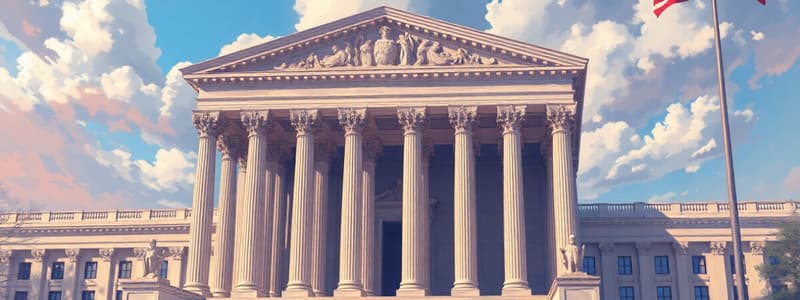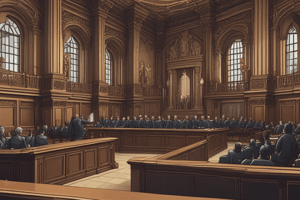Podcast
Questions and Answers
Which Article of the U.S. Constitution establishes the federal judiciary, including the Supreme Court?
Which Article of the U.S. Constitution establishes the federal judiciary, including the Supreme Court?
- Article I
- Article II
- Article III (correct)
- Article V
What restriction is placed on federal courts regarding the types of cases they can decide?
What restriction is placed on federal courts regarding the types of cases they can decide?
- They can only hear cases involving federal government employees.
- They can only decide cases involving amounts over \$1 million.
- They can only decide actual disputes, not issue advisory opinions. (correct)
- They are permitted to offer advisory opinions on complex legal matters.
Which of the following describes the power of judicial review?
Which of the following describes the power of judicial review?
- The power of Congress to impeach federal judges.
- The power of the president to veto laws passed by Congress.
- The power to determine if actions of the government are unconstitutional. (correct)
- The power to negotiate treaties with foreign nations.
In the U.S. court system, what is the typical order of appeals for a losing party?
In the U.S. court system, what is the typical order of appeals for a losing party?
What are precedents, as they relate to the U.S. court system?
What are precedents, as they relate to the U.S. court system?
How many U.S. Federal District Courts are there?
How many U.S. Federal District Courts are there?
In federal criminal cases, who represents the government?
In federal criminal cases, who represents the government?
How many circuit courts of appeals are in the U.S.?
How many circuit courts of appeals are in the U.S.?
What does it mean when a circuit court convenes en banc?
What does it mean when a circuit court convenes en banc?
What is a 'writ of certiorari' in the context of the U.S. Supreme Court?
What is a 'writ of certiorari' in the context of the U.S. Supreme Court?
Approximately how many cases does the U.S. Supreme Court typically hear each year?
Approximately how many cases does the U.S. Supreme Court typically hear each year?
What is the 'Rule of Four' in the context of the U.S. Supreme Court?
What is the 'Rule of Four' in the context of the U.S. Supreme Court?
What are Amicus Curiae briefs?
What are Amicus Curiae briefs?
In cases where the United States is party to a case before the Supreme Court, who typically argues the government's position?
In cases where the United States is party to a case before the Supreme Court, who typically argues the government's position?
What happens if there is a tie vote in the Supreme Court?
What happens if there is a tie vote in the Supreme Court?
What kind of opinion is written when justices agree with the majority decision, but for different reasons?
What kind of opinion is written when justices agree with the majority decision, but for different reasons?
Who nominates federal judges and Supreme Court Justices?
Who nominates federal judges and Supreme Court Justices?
What role does the American Bar Association (ABA) typically play in the selection of federal judges?
What role does the American Bar Association (ABA) typically play in the selection of federal judges?
What is the term 'nuclear option' referring to, in the context of contentious confirmations?
What is the term 'nuclear option' referring to, in the context of contentious confirmations?
How many justices serve on the Supreme Court today?
How many justices serve on the Supreme Court today?
Flashcards
What does Article III do?
What does Article III do?
Article III of the Constitution creates the federal judiciary, including the Supreme Court. It allows Congress to set up lower courts.
What is Judicial Review?
What is Judicial Review?
The power to determine if actions by other branches of government are unconstitutional, rendering the action null and void.
What is the U.S. dual court system?
What is the U.S. dual court system?
The U.S. has separate federal and state courts, but the Supreme Court is the final court of appeal.
How is the U.S. court system organized?
How is the U.S. court system organized?
Signup and view all the flashcards
What are precedents?
What are precedents?
Signup and view all the flashcards
What are Federal District Courts?
What are Federal District Courts?
Signup and view all the flashcards
What happens inside federal district courts?
What happens inside federal district courts?
Signup and view all the flashcards
What are Circuit Courts of Appeals?
What are Circuit Courts of Appeals?
Signup and view all the flashcards
Writs of certiorari
Writs of certiorari
Signup and view all the flashcards
Amicus Curiae briefs.
Amicus Curiae briefs.
Signup and view all the flashcards
How long are the US supreme oral arguments?
How long are the US supreme oral arguments?
Signup and view all the flashcards
What happens during the Supreme Court conference?
What happens during the Supreme Court conference?
Signup and view all the flashcards
What is a concurring opinion?
What is a concurring opinion?
Signup and view all the flashcards
How are federal judges selected?
How are federal judges selected?
Signup and view all the flashcards
What are Originalists?
What are Originalists?
Signup and view all the flashcards
What are Living Constitutionalists?
What are Living Constitutionalists?
Signup and view all the flashcards
Who was Merrick Garland nominated by?
Who was Merrick Garland nominated by?
Signup and view all the flashcards
What is the 'nuclear option'?
What is the 'nuclear option'?
Signup and view all the flashcards
Study Notes
- Lesson 10 is about the Federal Courts
The Consitution and The Judiciary
- Article III creates the federal judiciary, including the Supreme Court
- Congress can set up lower courts.
- Federal courts have jurisdiction over cases involving the Constitution, federal laws, treaties, and disputes between states and more
- Judges maintain their positions during good behavior and receive fixed compensation and protection from political pressures
- Courts decide real disputes only and don't give advisory opinions.
The Power of Judicial Review
- At the heart of the judicial system is the power of Judicial Review, the power to determine that actions from other branches of government and the states can be ruled unconstitutional, which would render the action null and void
- The Supreme Court established Judicial Review for itself in 1803, allowing all lower federal and state courts the same power.
The U.S. Court System
- Only state courts existed before the Constitution
- A dual court system—separate federal and state courts (each state has its own) is present
- The Supreme Court serves as the final court of appeal in all cases
- The U.S. court system operates as a hierarchy format
- Losing parties can appeal to circuit courts, then, if the justices agree, to the U.S. Supreme Court
- Precedents are guidelines from earlier cases (especially by the Supreme Court) that shape how courts operate.
Federal District Courts
- Federal District Courts handle initial cases including federal laws, the Constitution, Congress, and other federal issues that deal with both criminal and civil cases
- There are 94 U.S. Federal District Courts with every state holding at least one court, but larger states can have up to four courts
- Both sides question and present evidence and witnesses
- In criminal cases, the government is represented by a U.S. Attorney - one per district, chosen by the President with Senate approval.
- Juries decide the final verdict.
Circuit Courts of Appeals
- Circuit Courts examine appeals from federal district courts concentrating on legal reasoning, not facts.
- The cases are heard in the circuit including the district court where the case was originally heard.
- Lawyers use written briefs and give oral arguments in court, but no new evidence or witnesses are present
- The decision is made by a rotating panel of three judges.
- An en banc review (all judges present) adds extra credibility.
- These courts are arranged in 12 circuits with an additional 13th circuit hearing cases on patents and copyrights
The U.S. Supreme Court
- The U.S. Supreme Court takes cases from circuit courts (U.S. Courts of Appeals) or state supreme courts
- To appeal to the Supreme Court, the petitioner (party that lost in the lower-level court) asks the court for writs of certiorari, an order of the Supreme Court to call up the lower court records for review.
- The Supreme Court commonly hears no more than 100 cases annually, less than 2% of those petitioned
- Four out of nine justices must agree to hear a case, known as the Rule of Four
- Once the court accepts the instance and places it on the docket, each party submits written arguments, known as briefs
- Parties not involved can also submit briefs as advocates of one of the parties involved in the case, called Amicus Curiae briefs
- Each side presents oral arguments lasting roughly one hour, with each party presenting for 30 minutes to respond to questions from Justices
- The oral arguments are open to the public, without cameras
- The Solicitor General argues the government's position in cases where the United States is a party.
- Justices then discuss the case in conference (closed meeting) and make an initial vote
- In the event of a tie vote the lower court's decision stands
- The majority opinion explains the decision, agreeing with more than half of the nine justices
- A concurring opinion may be written by Justices who agree with the majority for a different reason
- A dissenting opinion may be written by Justices who disagree.
The Selection of Federal Judges/Justices
- Federal judges and Supreme Court Justices are nominated by the president and require a majority vote from the senate to be confirmed
- The president typically uses a referral list maintained by the American Bar Association
- The U.S. Constitution has no set requirements for federal judges
Senate Confirmation
- The Senate Judiciary Committee conducts an extensive, multi-day interview with the nominee before the Senate votes
- Senators ask tough questions to assess the nominee's views:
- Originalists favor justices in strict interpretation of the Constitution, limiting federal power and protecting states' rights
- Living Constitutionalists prefer a flexible understanding, allowing the federal government to adapt to changing times.
Contentious Confirmations
- In March 2016, President Barak Obama nominated Merrick Garland to replace Justice Antonin Scalia after his unexpected death
- The Senate majority leader Mitch McConnell saw an opportunity to hold on to the Republican seat and decided to hold no hearings on Garland's nomination
- McConnell's choice paid off when the Senate confirmed Neil Gorsuch in 2017 under President Trump
- Republicans used the "nuclear option” to forestall the democrats from filibustering the approval of Gorsuch.
Recent Contentious Confirmations
- Trump appointed Brett Kavanaugh to the Supreme Court in 2018
- During the confirmation hearings, Christine Blasely Ford accused Kavanaugh of sexually assaulting her in the 1980s, leading to an FBI investigation
- Kavanaugh was later confirmed by the Senate
The Current Supreme Court
- Congress decides the number of justices on the Supreme Court
- The court had six justices in 1789
- The Supreme Court contains nine justices since 1869
- The Justices are:
- Chief Justice, John G. Roberts
- Associate Justice Clarence Thomas
- Associate Justice Samuel A. Alito
- Associate Justice Sonia Sotomayor
- Associate Justice Elena Kagan
- Associate Justice Neil M. Gorsuch
- Associate Justice Brett M. Kavanaugh
- Associate Justice Amy Coney Barrett
- Associate Justice Ketanji Brown Jackson
- The Justices are:
Studying That Suits You
Use AI to generate personalized quizzes and flashcards to suit your learning preferences.





